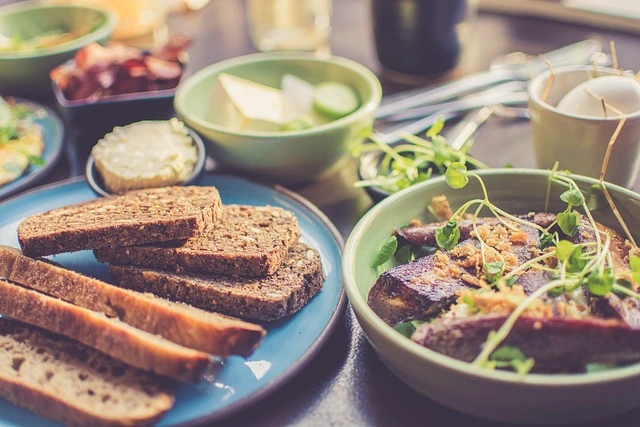Introduction to Healthy Meals
A. Definition of Healthy Meals
Healthy meals are balanced dishes that provide essential nutrients in appropriate proportions to support overall health and well-being. These meals typically include a variety of whole foods such as fruits, vegetables, lean proteins, whole grains, and healthy fats.
B. Importance of Healthy Eating
Healthy eating is essential for maintaining optimal health, preventing chronic diseases, and supporting overall vitality. By consuming nutritious meals, individuals can fuel their bodies with the necessary nutrients to function properly and thrive.
C. Overview of the Benefits of Consuming Healthy Meals
Consuming healthy meals offers numerous benefits, including improved energy levels, better weight management, enhanced cognitive function, stronger immune system, and reduced risk of developing chronic conditions such as heart disease, diabetes, and certain cancers. Making healthy food choices can positively impact overall quality of life and promote longevity.
Nutritional Components of Healthy Meals
A. Macronutrients in Healthy Meals
- Proteins: Essential for muscle repair, immune function, and hormone production, proteins are found in foods such as lean meats, poultry, fish, eggs, dairy products, legumes, and tofu.
- Carbohydrates: Serve as the body’s primary source of energy and are abundant in foods like fruits, vegetables, whole grains, and legumes.
- Fats: Important for brain health, hormone regulation, and absorption of fat-soluble vitamins, healthy fats are found in sources like avocados, nuts, seeds, olive oil, and fatty fish.
B. Micronutrients in Healthy Meals
- Vitamins: Play vital roles in various bodily functions such as metabolism, immune function, and vision. Vitamins are abundant in fruits, vegetables, whole grains, dairy products, and fortified foods.
- Minerals: Essential for bone health, fluid balance, and nerve function, minerals can be found in foods like leafy greens, nuts, seeds, dairy products, and seafood.
- Antioxidants: Help protect the body from oxidative stress and inflammation, reducing the risk of chronic diseases. Antioxidant-rich foods include berries, dark leafy greens, nuts, seeds, and colorful fruits and vegetables.
Planning and Preparing Healthy Meals (Word Count: 250-300)
A. Meal Planning Tips
Plan your meals ahead of time by creating a weekly or monthly meal plan. Consider incorporating a variety of nutrient-rich foods and recipes to ensure a balanced diet. Make a grocery list based on your meal plan to streamline shopping and avoid impulse purchases.
B. Healthy Cooking Methods
Opt for cooking methods that preserve the nutritional value of foods, such as steaming, baking, grilling, and sautéing, rather than frying. Use herbs, spices, and healthy oils like olive oil or avocado oil to add flavor without excess calories or unhealthy fats.
C. Importance of Portion Control
Practice portion control by using smaller plates, measuring servings, and being mindful of portion sizes. Avoid oversized portions, especially when dining out, and listen to your body’s hunger and fullness cues to prevent overeating.
Top 10 Healthy Meal Ideas (Word Count: 500-600)
A. Breakfast Options
Start your day with nutritious breakfast options such as oatmeal topped with fresh fruit and nuts, Greek yogurt with granola and berries, whole grain toast with avocado and eggs, or smoothie bowls packed with greens, fruits, and protein.
B. Lunch Ideas
Enjoy satisfying lunch options like mixed green salads with grilled chicken or tofu, whole grain wraps filled with lean protein and vegetables, quinoa bowls with roasted vegetables and hummus, or vegetable stir-fries with brown rice or quinoa.
C. Dinner Recipes
Prepare wholesome dinner recipes such as baked salmon with roasted vegetables, turkey chili with beans and vegetables, vegetable-packed soups and stews, or grilled tofu with steamed broccoli and quinoa.
D. Snack Suggestions
Snack on nutrient-rich foods like sliced vegetables with hummus, Greek yogurt with fruit and nuts, air-popped popcorn seasoned with herbs, or homemade energy balls made with oats, nuts, and dried fruit.
Benefits of Eating Healthy Meals
A. Weight Management
Consuming healthy meals that are balanced in nutrients and portion sizes can help support weight management goals by providing essential nutrients while controlling calorie intake.
B. Improved Energy Levels
Nutrient-dense meals provide the energy needed for daily activities and help prevent energy crashes and fatigue, leading to improved overall energy levels and productivity.
C. Better Overall Health
Eating a diet rich in fruits, vegetables, whole grains, lean proteins, and healthy fats supports overall health and well-being, reducing the risk of chronic diseases and promoting longevity and vitality.
FAQs healthy meals:
-
What is the healthiest meal you can eat?
The healthiest meal you can eat is one that includes a balanced combination of nutrient-rich foods from all food groups. Here’s an example:
Grilled salmon (a good source of omega-3 fatty acids and protein) Steamed broccoli (packed with vitamins, minerals, and fiber) Quinoa (a complete protein and rich in fiber and various nutrients) Mixed greens salad with olive oil and vinegar dressing (providing antioxidants, vitamins, and healthy fats) A side of fresh fruit like berries or an apple (high in vitamins, minerals, and fiber)
This meal provides a diverse array of nutrients, including protein, healthy fats, vitamins, minerals, and fiber, contributing to overall health and well-being. Additionally, it’s important to drink plenty of water throughout the day to stay hydrated.
-
What is the healthiest meal you can cook?
One of the healthiest meals you can cook is a colorful and balanced plate featuring a variety of nutrient-rich ingredients. Here’s a simple recipe for a nutritious and delicious meal:
-
- Grilled salmon with lemon and herbs
- Sautéed garlic spinach
- Quinoa pilaf
Assemble your plate with a serving of grilled salmon, sautéed garlic spinach, and quinoa pilaf for a well-rounded and nutritious meal. Enjoy!
-
What is best healthy meal?
The « best » healthy meal can vary depending on individual preferences, dietary needs, and cultural considerations. However, a generally excellent healthy meal would include a balance of nutrient-rich foods from various food groups. Here’s a versatile and nutritious example:
Grilled chicken breast:
-
- Lean protein source, rich in essential amino acids.
Roasted sweet potatoes:
-
- Complex carbohydrates, fiber, and vitamins.
Steamed broccoli:
-
- High in fiber, vitamins (such as vitamin C), and minerals (such as potassium).
Mixed leafy green salad:
-
- Provides a variety of vitamins, minerals, and antioxidants.
Quinoa pilaf:
-
- Whole grain option providing protein, fiber, and various nutrients.
Fresh fruit salad:
-
- Natural sugars, vitamins, minerals, and antioxidants.
This meal offers a diverse range of nutrients, including protein, carbohydrates, healthy fats, vitamins, and minerals, contributing to overall health and well-being. Adjustments can be made based on dietary preferences and needs, such as swapping chicken for tofu for a vegetarian option or adjusting portion sizes to meet individual caloric requirements.
-
What are the top 10 healthiest dinners?
Certainly! Here are ten healthy dinner options that are nutritious and delicious:
-
-
Grilled salmon with roasted vegetables:
-
Salmon is rich in omega-3 fatty acids, while roasted vegetables like broccoli, carrots, and bell peppers provide fiber, vitamins, and minerals.
-
-
Quinoa-stuffed bell peppers:
-
Quinoa is a complete protein and pairs well with vegetables like tomatoes, onions, and spinach stuffed into bell peppers.
-
-
Baked chicken breast with sweet potato mash and steamed green beans:
-
Lean chicken breast is a good source of protein, while sweet potatoes offer complex carbohydrates and fiber.
-
-
Lentil soup with whole grain bread:
-
Lentils are high in protein and fiber, and a hearty lentil soup paired with whole grain bread makes for a satisfying and nutritious meal.
-
-
Veggie stir-fry with tofu and brown rice:
-
Tofu provides plant-based protein in this stir-fry loaded with colorful vegetables like bell peppers, broccoli, carrots, and snap peas.
-
-
Grilled shrimp skewers with quinoa salad:
-
Shrimp is low in calories and high in protein, and when paired with a refreshing quinoa salad packed with vegetables and herbs, it makes for a light and nutritious dinner.
-
-
Turkey chili with mixed greens salad:
-
Ground turkey is a lean protein source, and a hearty turkey chili made with beans, tomatoes, and spices pairs well with a simple mixed greens salad dressed with olive oil and vinegar.
-
-
Baked cod with asparagus and wild rice:
-
Cod is a lean source of protein, and when baked with lemon and herbs, it’s flavorful and delicious alongside roasted asparagus and nutty wild rice.
-
-
Vegetable curry with brown rice:
-
A vegetarian curry made with an array of vegetables like cauliflower, carrots, peas, and spinach simmered in a flavorful sauce, served with brown rice for a complete and satisfying meal.
-
-
Stuffed acorn squash with quinoa and black beans:
-
Acorn squash halves filled with a mixture of quinoa, black beans, onions, and spices, then baked until tender, creating a nutritious and colorful dinner option.
These dinners provide a balance of protein, carbohydrates, healthy fats, vitamins, and minerals, making them excellent choices for a healthy lifestyle. Adjust ingredients and portions to suit individual preferences and dietary needs.
Mayo Clinic Healthy Recipes | EatingWell Healthy Meal Ideas | American Heart Association Healthy Eating

